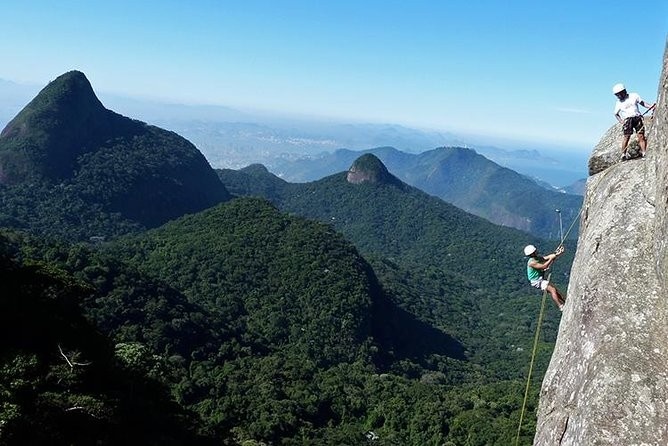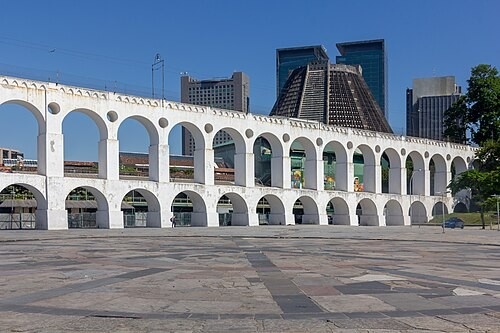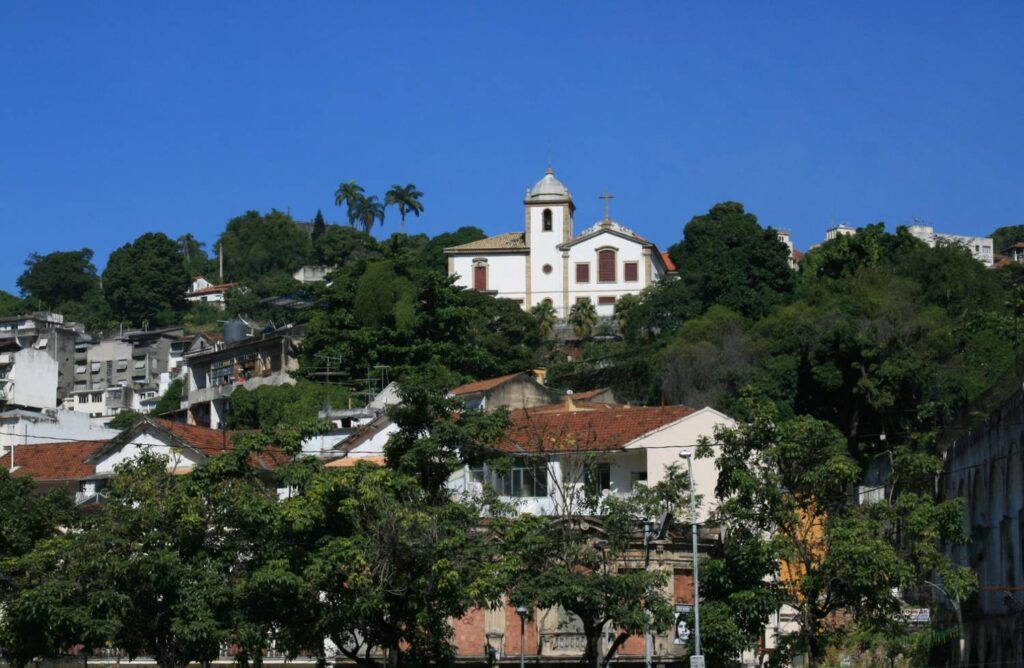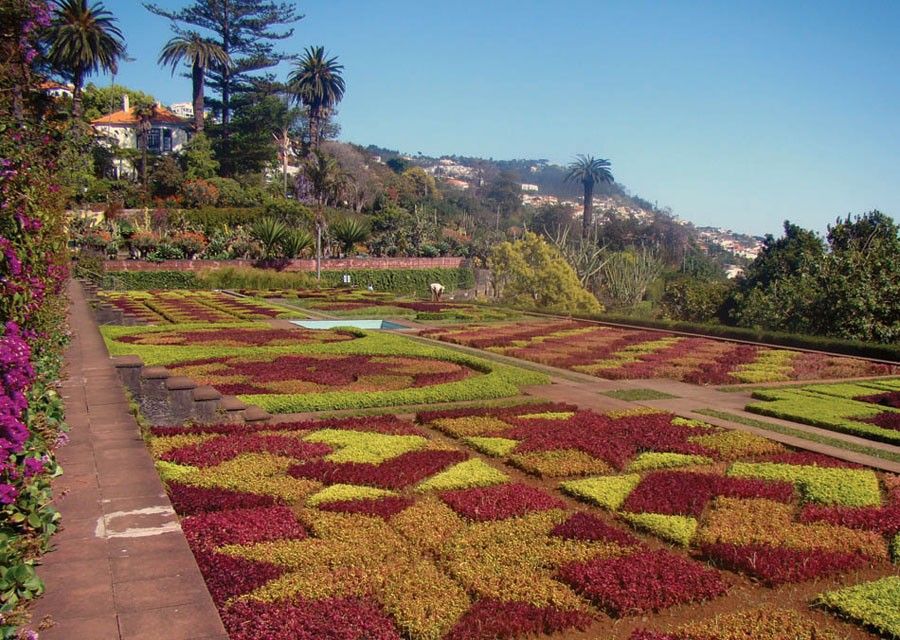
Rio de Janeiro, affectionately known as the “Marvelous City” (Cidade Maravilhosa), is a vibrant and breathtaking destination that truly captures the spirit of Brazil. Famous for its golden beaches, dramatic mountain backdrops, and electrifying culture, Rio is where nature, rhythm, and passion come together in perfect harmony.
Towering above the city, the iconic Christ the Redeemer statue welcomes visitors with open arms, offering panoramic views of lush forests, glittering coastlines, and the energetic cityscape below. At the foot of these scenic hills, neighborhoods pulse with life—from the lively beachside promenades of Copacabana and Ipanema to the historic streets of Santa Teresa, known for its colonial charm and bohemian vibe.
Rio’s natural beauty is nothing short of spectacular. Hike to the summit of Sugarloaf Mountain for a breathtaking sunset, stroll through the lush trails of Tijuca National Park—one of the largest urban forests in the world—or simply relax on the sands as the waves roll in and street performers provide a lively soundtrack.
But Rio is not just about views—it’s a celebration of culture. Whether you’re dancing to the infectious beat of samba in Lapa, joining the city-wide revelry of Carnival, or exploring its world-class museums and galleries, Rio’s rich traditions and artistic spirit are ever-present.
Food lovers will savor the city’s culinary delights, from sizzling street-side churrasco (Brazilian barbecue) to exotic tropical fruits and refreshing caipirinhas enjoyed under the sun.
Whether you’re an adventure seeker chasing trails and waves, a culture lover diving into music and art, or a beach enthusiast soaking up the sun, Rio de Janeiro promises an unforgettable escape full of color, rhythm, and soul.
🗓️ Best Time to Visit Rio de Janeiro
The ideal time to visit Rio is from December to March, during the Brazilian summer, when the city buzzes with energy, festivals, and warm weather perfect for the beach.
- December to March: Hot and humid with plenty of sunshine; this is also the carnival season, one of the most exciting times to experience Rio’s vibrant culture.
- April to June & August to November: These months are cooler and less humid, great for sightseeing with fewer crowds.
- July can be cooler and sometimes rainy but is still a good time to explore.
💰 Currency and Practical Info
- Currency: Brazilian Real (BRL
- Language: Portuguese is the official language; English is spoken in tourist areas.
- Transport: Rio has an extensive metro, buses, and taxis. Walking is great in neighborhoods like Copacabana and Ipanema.
- Daily Budget:
- Budget travelers: $30–$60 USD
- Mid-range: $60–$120 USD
- Luxury: $120+ USD
🌟 Top 10 Best Places to Visit in Rio de Janeiro
Christ the Redeemer (Cristo Redentor)

Standing majestically atop the Corcovado Mountain, Christ the Redeemer is one of the world’s most recognizable landmarks and a powerful symbol of peace and faith. This towering statue of Jesus Christ, with arms outstretched over the city of Rio de Janeiro, offers breathtaking panoramic views and a profound cultural and spiritual experience. It represents not only Brazil’s vibrant spirit but also a universal message of hope and unity.
🌟 Highlights of Christ the Redeemer
• 🗽 The Statue
Measuring 30 meters (98 feet) tall, with an arm span of 28 meters (92 feet), the statue is made of reinforced concrete and soapstone. It was completed in 1931 and is an outstanding example of Art Deco sculpture.
• 🌄 Corcovado Mountain
Perched 710 meters (2,330 feet) above sea level, the statue overlooks Rio de Janeiro’s stunning landscapes, including Sugarloaf Mountain, Copacabana Beach, and Tijuca Forest.
• 📸 Panoramic Views
Visitors can enjoy some of the best views in the city, making it a perfect spot for photography, especially at sunrise or sunset.
• 🚠 Access and Transportation
Reach the statue via the historic Corcovado Rack Railway, a scenic 20-minute ride through the Tijuca National Park, or by van and hiking trails for the more adventurous.
• 🕊️ Cultural and Spiritual Significance
Christ the Redeemer is a pilgrimage site for many and hosts religious ceremonies, reflecting its deep spiritual importance.
🚗 How to Get There
• By Train:
The Corcovado Rack Railway departs from Cosme Velho station, offering a comfortable and scenic journey.
• By Van:
Authorized vans provide transport from various points in Rio, including Copacabana and Largo do Machado.
• On Foot:
For hikers, there are trails through Tijuca Forest leading to the summit, suitable for those looking for an active experience.
🕒 Visitor Information
• Opening Hours:
Open daily from 8:00 AM to 7:00 PM, with last admission around 6:00 PM.
• Entry Fee:
Ticket prices vary; pre-booking online is recommended to avoid long lines and guarantee access.
• Recommended Visit Duration:
Plan at least 2 hours to include travel time and exploring the site.
💡 Travel Tips
• 🎟️ Book Tickets Online in Advance:
The site is extremely popular; early booking ensures smoother entry.
• 👟 Wear Comfortable Shoes:
There are stairs and uneven surfaces at the top.
• ☀️ Visit Early or Late in the Day:
To avoid crowds and enjoy cooler temperatures.
• 📸 Bring a Camera or Smartphone:
For capturing spectacular cityscapes and the iconic statue itself.
Christ the Redeemer is not just a breathtaking monument but a profound symbol of faith, peace, and Brazilian pride. A visit to this iconic statue offers awe-inspiring views and a chance to connect with the heart of Rio de Janeiro’s cultural and spiritual heritage.
Sugarloaf Mountain (Pão de Açúcar)

Photo by Sébastien Goldberg on Unsplash
Rising dramatically from the waters of Guanabara Bay, Sugarloaf Mountain (Pão de Açúcar) is one of Rio de Janeiro’s most famous natural landmarks and a symbol of Brazil’s vibrant spirit. This towering granite peak offers breathtaking panoramic views of the city, beaches, and Atlantic Ocean, making it a must-visit for travelers seeking stunning landscapes combined with a thrilling cable car experience. Whether at sunrise, sunset, or under the city lights, Sugarloaf captivates visitors with its unique beauty.
🌟 Highlights of Sugarloaf Mountain
• 🚡 Cable Car Ride
Take the iconic two-stage cable car journey from Praia Vermelha to Morro da Urca and then to Sugarloaf’s summit. The ride provides spectacular views of Rio’s coastline, Christ the Redeemer statue, and the cityscape.
• 🌅 Panoramic Vistas
At the summit (396 meters/1,299 feet), enjoy 360-degree views of Rio de Janeiro, including Copacabana and Ipanema beaches, the historic downtown, and surrounding mountains.
• 🧗♂️ Rock Climbing & Hiking
For the adventurous, Sugarloaf offers challenging rock climbing routes with guided tours. Nearby Morro da Urca features hiking trails suitable for all levels.
• 📸 Sunset & Night Views
Sunset atop Sugarloaf is magical as the city glows with golden light. At night, the illuminated skyline offers a dazzling spectacle.
• 🛍️ Visitor Facilities
The summit has a café, gift shops, and viewing platforms to enhance your visit.
🚗 How to Get There
• By Public Transport:
From downtown Rio or Copacabana, take buses or taxis to the cable car station at Praia Vermelha.
• By Taxi or Ride-Share:
Easy access from most parts of the city; parking is limited near the cable car base station.
🕒 Visitor Information
• Best Time to Visit:
Early morning or late afternoon for cooler temperatures and less crowding. Sunset visits are especially popular.
• Entry Fees:
Round-trip cable car tickets cost around R$130 (~€25), with discounts for children and seniors.
• Recommended Visit Duration:
1.5 to 2 hours to enjoy the cable car rides, summit views, and explore the area.
💡 Travel Tips
• 👟 Wear Comfortable Shoes:
There’s some walking and stairs at the summit viewing areas.
• 📸 Bring a Camera:
The vistas are picture-perfect—wide-angle lenses are great for capturing the scenery.
• 🕶️ Sun Protection:
Bring sunscreen, hats, and water, especially during sunny days.
• 🏞️ Combine with Nearby Attractions:
Visit nearby Praia Vermelha beach or the historic neighborhood of Urca for a full day experience.
Sugarloaf Mountain is an unforgettable Rio de Janeiro icon offering breathtaking views and exhilarating experiences. Whether you’re gliding up the cable car or admiring the sunset from the summit, it’s a must-see destination that perfectly captures the natural beauty and vibrant energy of this incredible city.
Copacabana Beach

Photo by Eelco Böhtlingk on Unsplash
Famed worldwide for its vibrant atmosphere, golden sands, and stunning views of the Atlantic Ocean, Copacabana Beach is one of Rio de Janeiro’s most iconic landmarks. Stretching over 4 kilometers, this lively beach is a magnet for locals and tourists alike, offering everything from sunbathing and beach sports to bustling nightlife and cultural events. Whether you’re seeking relaxation or excitement, Copacabana promises an unforgettable seaside experience.
🌟 Highlights of Copacabana Beach
• 🌞 Sun and Sand
Enjoy the wide, crescent-shaped beach with soft, golden sand perfect for lounging, swimming, and people-watching.
• 🏐 Beach Sports and Activities
Join a game of beach volleyball, football (soccer), or try stand-up paddleboarding. The beach is also popular for jogging and cycling along its famous promenade.
• 🍹 Kiosks and Beach Bars
Refresh yourself with fresh coconut water, caipirinhas, or traditional Brazilian snacks from numerous kiosks and bars lining the beach.
• 🎉 Festivals and Events
Copacabana hosts world-famous events like New Year’s Eve celebrations with spectacular fireworks, live concerts, and the annual Carnival parties.
• 🏨 Nearby Attractions
Explore nearby landmarks such as Fort Copacabana, the historic promenade designed by Roberto Burle Marx, and vibrant neighborhoods full of restaurants and shops.
🚗 How to Get There
• By Metro:
Take Rio’s metro to Cardeal Arcoverde or Siqueira Campos stations, both within walking distance of the beach.
• By Bus or Taxi:
Numerous buses and taxis serve Copacabana from across Rio, providing easy access.
🕒 Visitor Information
• Best Time to Visit:
Year-round, with summer (December to March) being the busiest and most festive season.
• Safety Tips:
Stay in well-populated areas, avoid flaunting valuables, and swim near lifeguard stations.
• Facilities:
Public restrooms, showers, and changing rooms are available at several points along the beach.
💡 Travel Tips
• 🧴 Use Sunscreen and Stay Hydrated:
The Brazilian sun can be intense, so protect your skin and drink plenty of water.
• 👟 Wear Comfortable Footwear:
The promenade is perfect for walking or biking, so bring suitable shoes.
• 🎶 Experience Local Music and Dance:
Enjoy samba and bossa nova performances often found at beach bars and nearby venues.
• 📸 Capture Iconic Views:
Don’t miss photos of the famous black-and-white wave-patterned promenade and the breathtaking ocean vistas.
Copacabana Beach is more than just a seaside destination — it’s a vibrant cultural hub that embodies the energy and spirit of Rio de Janeiro. Whether relaxing under the sun, enjoying beach sports, or taking part in lively festivals, a visit to Copacabana promises memories that will last a lifetime.
Ipanema Beach

Photo by Raphael Nogueira on Unsplash
Located in the vibrant neighborhood of Ipanema in Rio de Janeiro, Ipanema Beach is one of the world’s most famous urban beaches, celebrated for its golden sands, sparkling Atlantic waters, and lively cultural scene. Known internationally thanks to the classic bossa nova song “The Girl from Ipanema,” this beach perfectly blends natural beauty with the city’s stylish, laid-back lifestyle. Whether you’re sunbathing, surfing, or enjoying local street food, Ipanema invites you to experience the quintessential Carioca vibe.
🌟 Highlights of Ipanema Beach
• 🏄♂️ Surfing & Water Sports
With consistent waves, Ipanema is a hotspot for surfers of all levels. Stand-up paddleboarding and beach volleyball are also popular.
• 🌞 Sunbathing & Beach Culture
Relax on soft sands, rent colorful umbrellas and loungers, or join locals practicing yoga and capoeira.
• 🌈 Diverse Beach Sections
The beach is divided into different “postos” (lifeguard stations), each attracting distinct crowds—from families to LGBTQ+ communities and sports enthusiasts.
• 🍹 Chiringuitos & Beach Bars
Sip on fresh coconut water, caipirinhas, or enjoy traditional snacks like pastel and acarajé from lively kiosks and vendors.
• 🎶 Live Music & Street Performers
Throughout the day and especially in the evenings, enjoy spontaneous samba sessions and local musicians adding rhythm to the atmosphere.
• 🌅 Sunset Views
Watch the sun dip behind the Dois Irmãos (Two Brothers) mountains, painting the sky in vivid hues—a perfect end to the day.
🚗 How to Get There
• By Metro:
Ipanema is served by the General Osório station on Rio’s metro line, a short walk to the beach.
• By Bus or Taxi:
Frequent buses and taxis connect Ipanema with other Rio neighborhoods.
🕒 Visitor Information
• Best Time to Visit:
Year-round beach weather, with summer (December–March) being busiest and warmest.
• Safety:
Popular areas are well-patrolled, but stay aware of your belongings and avoid isolated spots after dark.
• Facilities:
Showers, public restrooms, and lifeguard stations are available along the beach.
💡 Travel Tips
• 🏖️ Bring Sunscreen & Water:
Protect yourself from the tropical sun and stay hydrated.
• 👙 Dress Code:
Brazilian beachwear tends to be minimal; bikinis and swim trunks are standard.
• 📸 Capture the Moment:
Sunrise and sunset offer spectacular photo opportunities with iconic landscapes.
• 🍽️ Explore Nearby:
After the beach, explore Ipanema’s bustling streets filled with shops, restaurants, and nightlife.
Ipanema Beach embodies the vibrant soul of Rio de Janeiro, where sun, sea, and samba come together in a joyful celebration of life. Its stunning setting and energetic ambiance make it a must-visit destination for anyone wanting to experience the magic of Brazil’s beach culture.
Tijuca National Park

Nestled within the bustling city of Rio de Janeiro, Tijuca National Park stands as one of the world’s largest urban rainforests. This lush green oasis offers a refreshing escape from city life with its dense vegetation, cascading waterfalls, and diverse wildlife. Perfect for nature lovers and adventure seekers, Tijuca is a unique blend of natural beauty and urban accessibility, showcasing Brazil’s rich biodiversity right in the heart of Rio.
🌟 Highlights of Tijuca National Park
• 🌲 Lush Rainforest Trails
Explore miles of hiking paths winding through dense Atlantic Forest, offering varying levels of difficulty and rewarding visitors with breathtaking views and tranquil nature.
• 💦 Waterfalls
Discover stunning waterfalls such as Cascatinha Taunay and Tijuca Falls, ideal spots for photos and a refreshing break during hikes.
• 🦜 Wildlife Spotting
Encounter a variety of birds, monkeys, and native plants that make Tijuca a vital ecological haven.
• 🏞️ Scenic Viewpoints
Visit iconic lookouts like Vista Chinesa and Pico da Tijuca, the park’s highest peak, where panoramic views of Rio de Janeiro, Sugarloaf Mountain, and Christ the Redeemer await.
• 🛶 Outdoor Activities
Beyond hiking, the park offers opportunities for rock climbing, mountain biking, and guided nature tours.
🚗 How to Get There
• By Car or Taxi:
Easily accessible from central Rio; parking is available near main entrances like Vista Chinesa and the Tijuca Forest Visitor Center.
• By Public Transport:
Bus routes connect to the park’s various access points; check local schedules for the best routes.
🕒 Visitor Information
• Opening Hours:
The park is generally open from 8:00 AM to 5:00 PM daily.
• Entry Fee:
Admission to the park is free, but some guided tours or activities may require a fee.
• Recommended Visit Duration:
Plan at least half a day to explore popular trails and viewpoints.
💡 Travel Tips
• 👟 Wear Hiking Shoes:
Trails can be rugged and slippery, so sturdy footwear is essential.
• 🧴 Bring Insect Repellent and Water:
Protect yourself from insects and stay hydrated during your visit.
• 📸 Don’t Forget Your Camera:
Capture stunning landscapes and wildlife moments.
• 🧭 Consider a Guided Tour:
Local guides can enrich your experience with knowledge about flora, fauna, and history.
Tijuca National Park offers a rare opportunity to immerse yourself in a vibrant rainforest just minutes from Rio’s urban center. Whether hiking to scenic peaks, spotting exotic wildlife, or simply breathing in fresh forest air, this urban jungle is a must-visit for nature enthusiasts and travelers seeking adventure.
Lapa Arches (Arcos da Lapa)

Rising impressively in the vibrant Lapa district of Rio de Janeiro, the Lapa Arches (Arcos da Lapa) are a striking remnant of colonial engineering and a symbol of the city’s lively spirit. Originally built as an aqueduct in the 18th century to bring fresh water from the Carioca River to downtown Rio, these towering stone arches now serve as a bridge for the city’s famous tram and form the heart of Rio’s nightlife and cultural scene. The Lapa Arches perfectly blend history, architecture, and modern energy.
🌟 Highlights of Lapa Arches
• 🏛️ Architectural Marvel
The aqueduct features 42 massive stone arches spanning 270 meters, showcasing impressive Portuguese colonial design and engineering.
• 🚋 Santa Teresa Tram Bridge
Today, the arches carry the historic yellow tram connecting Lapa with the bohemian Santa Teresa neighborhood, offering scenic city views.
• 🎶 Nightlife & Samba Scene
Lapa is renowned for its bustling bars, clubs, and live music venues, where samba, choro, and Brazilian rhythms fill the streets until dawn.
• 🎨 Street Art & Cultural Vibe
The surrounding area bursts with colorful murals, vibrant street art, and a youthful atmosphere that celebrates Rio’s creative pulse.
• 📸 Photo Opportunities
The arches are a popular spot for photography, especially at sunset or illuminated at night, framing the lively streets below.
🚗 How to Get There
• By Metro:
The nearest metro station is Cinelândia, a short walk to the arches.
• By Taxi or Bus:
Well-connected from other Rio neighborhoods, with frequent public transport options.
🕒 Visitor Information
• Best Time to Visit:
Evenings and weekends when the area buzzes with nightlife; daytime visits are great for architecture and cultural exploration.
• Entry Fees:
Free to visit and explore the arches and surrounding streets.
• Recommended Visit Duration:
1–3 hours depending on whether you stay for nightlife or just sightseeing.
💡 Travel Tips
• 👟 Wear Comfortable Shoes:
Explore the cobblestone streets and nearby hills comfortably.
• 🕶️ Stay Aware at Night:
While lively, the area can be crowded—stay cautious with personal belongings.
• 🍽️ Try Local Food & Drinks:
Sample street food, traditional Brazilian snacks, and caipirinhas at nearby bars.
• 🚋 Ride the Tram:
Combine your visit with a scenic tram ride to Santa Teresa for a full cultural experience.
The Lapa Arches are much more than a historic structure—they’re a vibrant gateway to Rio’s cultural heartbeat. Whether admiring the architectural feat by day or dancing to samba rhythms by night, visiting Arcos da Lapa offers a dynamic glimpse into the past and present of one of Brazil’s most spirited neighborhoods.
Santa Teresa Neighborhood

Nestled on a hillside overlooking the city, Santa Teresa is a vibrant and charming neighborhood known for its colonial architecture, narrow winding streets, and lively arts scene. With a creative spirit and a laid-back vibe, Santa Teresa attracts artists, musicians, and travelers seeking an authentic Rio experience away from the tourist crowds. This bohemian enclave offers a rich blend of history, culture, and breathtaking views
🌟 Highlights of Santa Teresa
• 🏘️ Historic Architecture
Stroll past colorful colonial mansions, quaint villas, and cobblestone streets that tell stories of Rio’s past and its artistic evolution.
• 🎨 Art Galleries and Studios
Explore numerous galleries showcasing contemporary Brazilian art, street murals, and artisan workshops where you can meet local creators.
• 🎶 Live Music and Nightlife
Enjoy samba and bossa nova performances in cozy bars and live music venues, creating an intimate atmosphere filled with authentic Brazilian rhythms.
• 🌄 Spectacular Views
Visit Largo do Guimarães or Parque das Ruínas for panoramic views of downtown Rio, Sugarloaf Mountain, and Guanabara Bay.
• 🚋 Historic Tram (Bonde de Santa Teresa)
Ride the iconic yellow tram through the neighborhood’s steep hills and winding roads — a nostalgic experience and practical way to explore.
🚗 How to Get There
• By Taxi or Ride-share:
Easiest way to reach Santa Teresa, especially in the evenings or from downtown Rio.
• By Tram:
Take the historic Bonde tram from downtown Rio for a scenic and authentic arrival.
• By Bus:
Several bus routes connect Santa Teresa with other parts of Rio, though the tram and taxi are more popular.
🕒 Visitor Information
• Best Time to Visit:
Afternoons and early evenings are ideal for exploring galleries and enjoying live music.
• Safety Tips:
Stay aware of your surroundings and avoid poorly lit areas at night; the neighborhood is generally safe but caution is advised.
• Local Markets and Shops:
Browse weekend artisan markets for handmade crafts, jewelry, and souvenirs.
💡 Travel Tips
• 👟 Wear Comfortable Shoes:
Steep hills and cobblestones mean good footwear is essential.
• 📸 Bring Your Camera:
Capture colorful street art, charming streets, and sweeping city views.
• 🍽️ Try Local Cuisine:
Sample traditional Brazilian dishes and street food at cozy cafés and restaurants.
• 🎉 Check Event Calendars:
Santa Teresa often hosts festivals, art walks, and cultural events worth timing your visit for.
Santa Teresa is a must-visit neighborhood for travelers wanting to experience the authentic soul of Rio de Janeiro — a place where history, art, and community converge to create a truly unique and inspiring atmosphere.
Maracanã Stadium

Photo by AXP Photography on Unsplash
Standing as one of the world’s most iconic sports arenas, Maracanã Stadium in Rio de Janeiro is a temple of football passion and Brazilian culture. Since its opening in 1950 for the FIFA World Cup, Maracanã has witnessed some of the greatest moments in football history, from electrifying matches to unforgettable concerts. Its vast capacity, electric atmosphere, and deep cultural significance make it a must-visit for sports fans and visitors eager to feel the pulse of Brazil’s favorite sport.
🌟 Highlights of Maracanã Stadium
• ⚽ Historic Football Matches
Experience the home of legendary games, including the 1950 and 2014 FIFA World Cups and the Copa América finals, where legends like Pelé, Zico, and Neymar have dazzled.
• 🏟️ Modern Renovations
The stadium has been upgraded with state-of-the-art facilities, comfortable seating, and improved accessibility, blending modern amenities with its historic charm.
• 🎤 Concert Venue
Beyond sports, Maracanã hosts world-class music concerts featuring global stars, adding to its status as a cultural landmark.
• 🏆 Guided Tours
Take behind-the-scenes tours to explore the locker rooms, press areas, players’ tunnel, and pitch, gaining insight into the stadium’s legacy.
• 🛍️ Maracanã Museum & Shop
Discover memorabilia, trophies, and exhibits that celebrate Brazil’s football history, and pick up official merchandise.
🚗 How to Get There
• By Metro:
Maracanã station on Rio’s metro lines is just steps from the stadium.
• By Bus or Taxi:
Well-served by local buses and taxis from across the city
🕒 Visitor Information
• Best Time to Visit:
Match days for the full electric atmosphere, or weekdays for quieter guided tours.
• Entry Fees:
Tour prices vary around R$40–60 (~€7–11), depending on the package.
• Recommended Visit Duration:
1.5 to 2 hours for tours; 3+ hours for match day experiences.
💡 Travel Tips
• 👕 Wear Team Colors:
Show your support by sporting jerseys or scarves, especially on match days.
• 🎟️ Book Tickets Early:
For games and concerts, tickets can sell out quickly.
• 🍴 Food & Drink:
Stadium vendors offer traditional snacks like pastel and cold beverages.
• 🛡️ Safety:
Follow stadium guidelines and arrive early to avoid crowds.
Maracanã Stadium is more than just a sports venue—it’s a living symbol of Brazil’s passion, unity, and love for football. Whether cheering with thousands of fans during a match or exploring its historic halls on a tour, visiting Maracanã immerses you in the thrilling spirit of Brazilian culture and sportsmanship.
Botanical Garden (Jardim Botânico)

The Rio de Janeiro Botanical Garden (Jardim Botânico) is a lush, tranquil haven nestled in the southern part of the city, offering visitors a chance to explore one of Brazil’s most important collections of native and exotic plants. Founded in 1808, this historic garden is a paradise for nature lovers, botanists, and anyone seeking a peaceful retreat amidst stunning greenery and vibrant wildlife. Its beautifully landscaped grounds combine scientific research with leisure, culture, and education.
🌟 Highlights of Rio de Janeiro Botanical Garden
• 🌴 Diverse Plant Collections
Wander through over 6,500 species of tropical and subtropical plants, including rare orchids, towering palm trees, and the iconic giant Amazon water lilies.
• 🦜 Wildlife Spotting
Encounter colorful birds such as toucans, parrots, and hummingbirds that inhabit the garden, along with small monkeys and butterflies.
• 🏛️ Historic Landmarks
Visit the beautiful imperial palm alley, the Japanese Garden, and the impressive Fountain of the Muses, each adding cultural and architectural charm.
• 🌿 Research and Conservation
Learn about the garden’s role in plant conservation, scientific study, and environmental education through its visitor center and guided tours.
• 🎨 Art and Culture
Enjoy open-air art exhibits and cultural events hosted in the serene garden environment.
🚗 How to Get There
• By Metro and Bus:
Take the Metro to Jardim Botânico station, then a short bus or taxi ride will get you directly to the garden entrance.
• By Taxi or Ride-share:
Convenient and popular for tourists, especially from nearby neighborhoods like Ipanema and Copacabana.
🕒 Visitor Information
• Opening Hours:
Open daily from 8:00 AM to 5:00 PM.
• Entry Fee:
Tickets cost around R$15 (Brazilian Real) for adults; discounts available for students and seniors.
• Recommended Visit Duration:
Plan 2 to 3 hours to fully explore the extensive grounds and enjoy the tranquility.
💡 Travel Tips
• 👟 Wear Comfortable Shoes:
The garden covers a large area with paved and natural paths.
• 🧴 Use Sunscreen and Bring Water:
Stay protected and hydrated, especially on sunny days.
• 📸 Bring a Camera or Smartphone:
Capture vibrant flora and exotic wildlife.
• 🎧 Consider a Guided Tour or Audio Guide:
Gain deeper insights into the garden’s botanical treasures and history.
The Rio de Janeiro Botanical Garden is a must-visit green sanctuary that beautifully showcases Brazil’s rich plant diversity and natural heritage. It offers a peaceful escape from the city buzz, perfect for families, nature enthusiasts, and anyone looking to connect with the environment.
Museum of Tomorrow (Museu do Amanhã)

Perched on the waterfront of Rio de Janeiro’s revitalized Porto Maravilha district, the Museum of Tomorrow (Museu do Amanhã) is a striking blend of cutting-edge architecture and innovative science. Designed by renowned Spanish architect Santiago Calatrava, this museum explores the future of our planet through immersive exhibitions focusing on climate change, technology, and human sustainability. It’s a must-visit destination for curious minds eager to engage with big questions about the world we’re shaping.
🌟 Highlights of the Museum of Tomorrow
• 🏛️ Architectural Wonder
The museum’s futuristic design features sweeping white wings that resemble a bird in flight, integrated solar panels, and an eco-friendly construction that harmonizes with the harbor landscape.
• 🌍 Interactive Exhibitions
Engage with thought-provoking displays and multimedia installations about ecology, biodiversity, innovation, and social challenges facing humanity.
• 🔬 Science & Technology Focus
Explore themes of climate science, renewable energy, and sustainable cities through immersive technology and hands-on learning.
• 🌱 Future-Focused Programs
Participate in workshops, talks, and events aimed at inspiring environmental awareness and action.
• 📸 Scenic Location
Enjoy stunning views of Guanabara Bay and the Rio skyline from the museum’s terraces.
🚗 How to Get There
• By Metro:
Closest metro station is Uruguaiana, followed by a short walk.
• By Bus or Taxi:
Located in the Porto Maravilha area, accessible by various bus lines and taxis.
🕒 Visitor Information
• Best Time to Visit:
Weekdays and mornings for a quieter experience; weekends can be busier.
• Entry Fees:
Tickets cost around R$40 (~€7), with discounts for students and seniors.
• Recommended Visit Duration:
2 to 3 hours to fully explore the exhibitions and enjoy the surroundings.
💡 Travel Tips
• 🎟️ Buy Tickets Online:
To avoid queues, especially on weekends and holidays.
• 📱 Download the Museum App:
Enhance your visit with additional multimedia content and interactive guides.
• 👟 Wear Comfortable Shoes:
Exhibits require walking and some standing.
• ☀️ Combine with Nearby Attractions:
Explore the nearby Rio Art Museum (MAR) and the historic port district.
The Museum of Tomorrow stands as a beacon of hope and curiosity in Rio de Janeiro, inviting visitors to reflect on humanity’s impact and imagine sustainable futures. Its inspiring blend of art, science, and technology offers a unique and uplifting experience, making it a highlight for travelers passionate about the planet and innovation.
💡 Travel Tips for Rio de Janeiro
- Stay vigilant and keep valuables secure, especially in crowded tourist areas.
- Use official taxis or ride-share apps for safe transportation.
- Try local dishes like feijoada (black bean stew) and fresh tropical fruits.
- Learn a few Portuguese phrases—locals appreciate the effort!
- Book popular attractions like Christ the Redeemer tickets online in advance to avoid lines.
🌟 Final Thoughts
Rio de Janeiro is a city of contrasts—where natural wonders meet vibrant urban life, and every corner pulses with energy and warmth. Whether you’re gazing at iconic landmarks, dancing samba in the streets, or relaxing on golden beaches, Rio offers experiences that stay with you forever.
Ready to embrace the magic of Rio? Your Brazilian adventure awaits!

I’m Shreyash Mhashilkar, an IT professional who loves building user-friendly, scalable digital solutions. Outside of coding, I enjoy researching new places, learning about different cultures, and exploring how technology shapes the way we live and travel. I share my experiences and discoveries to help others explore new places, cultures, and ideas with curiosity and enthusiasm.






